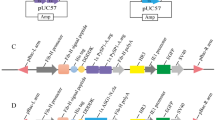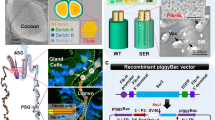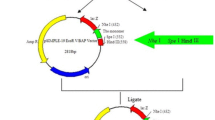Abstract
The high tensile strength and biocompatibility of spider dragline silk makes it a desirable material in many engineering and tissue regeneration applications. Here, we present the feasibility to produce recombinant proteins in transgenic tobacco Nicotiana tabacum with sequences representing spider silk protein building blocks . Recombinant mini-spidroins contain native N- and C-terminal domains of major ampullate spidroin 1 (rMaSp1) or rMaSp2 flanking an abbreviated number (8, 16 or 32) of consensus repeat domains. Two different expression plasmid vectors were tested and a downstream chitin binding domain and self-cleavable intein were included to facilitate protein purification. We confirmed gene insertion and RNA transcription by PCR and reverse-transcriptase PCR, respectively. Mini-spidroin production was detected by N-terminus specific antibodies. Purification of mini-spidroins was performed through chitin affinity chromatography and subsequent intein activation with reducing reagent. Mini-spidroins, when dialyzed and freeze-dried, formed viscous gelatin-like fluids.




Similar content being viewed by others
References
Allmeling C, Jokuszies A, Reimers K, Kall S, Choi CY, Brandes G, Kasper C, Scheper T, Guggenheim M, Vogt PM (2008) Spider silk fibres in artificial nerve constructs promote peripheral nerve regeneration. Cell Prolif 41:408–420
Altman GH, Diaz F, Jakuba C, Calabro T, Horan RL, Chen J, Lu H, Richmond J, Kaplan DL (2003) Silk-based biomaterials. Biomaterials 24:401–416
Arcidiacono S, Mello C, Kaplan D, Cheley S, Bayley H (1998) Purification and characterization of recombinant spider silk expressed in Escherichia coli. Appl Microbiol Biotechnol 49:31–38
Ayoub NA, Garb JE, Tinghitella RM, Collin MA, Hayashi CY (2007) Blueprint for a high-performance biomaterial: full-length spider dragline silk genes. PLoS One. doi:10.1371/journal.pone.0000514
Beckwitt R, Arcidiacono S (1994) Sequence conservation in the C-terminal region of spider silk proteins (Spidroin) from Nephila clavipes (Tetragnathidae) and Araneus bicentenarius (Araneidae). J Biol Chem 269:6661–6663
Bini E, Knight DP, Kaplan DL (2004) Mapping domain structures in silks from insects and spiders related to protein assembly. J Mol Biol 335:27–40
Dey N, Maiti I (1999) Structure and promoter/leader deletion analysis of mirabilis mosaic virus (MMV) full-length transcript promoter in transgenic plants. Plant Mol Biol 40:771–782
Dicko C, Vollrath F, Kenney JM (2004) Spider silk protein refolding is controlled by changing pH. Biomacromolecules 5:704–710
Evans TC, Benner J, Xu M-Q (1999) The cyclization and polymerization of bacterially expressed proteins using modified self-splicing inteins. J Biol Chem 274:18359–18363
Fahnestock SR, Bedzyk LA (1997) Production of synthetic spider dragline silk protein in Pichia pastoris. Appl Microbiol Biotechnol 47:33–39
Fisher D, Guiltinan M (1995) Rapid, efficient production of homozygous transgenic tobacco plants with Agrobacterium tumefaciens: a seed-to-seed protocol. Plant Mol Biol Rep 13:278–289
Gaines IV, Marcotte WR Jr (2008) Identification and characterization of multiple Spidroin 1 genes encoding major ampullate silk proteins in Nephila clavipes. Insect Mol Biol. doi:10.1111/j.1365-2583.2008.00828.x
Gaines WA, Marcotte WR Jr (2011) Recombinant dragline silk-like proteins-expression and purification. AATCC Rev 11:75–79
Gaines WA, Sehorn MG, Marcotte WR Jr (2010) Spidroin N-terminal domain promotes a pH-dependent association of silk proteins during self-assembly. J Biol Chem 285:40745–40753
Gao Z, Lin Z, Huang W, Lai CC, Fan JS, Yang D (2013) Structural characterization of minor ampullate spidroin domains and their distinct roles in fibroin solubility and fiber formation. PLoS One. doi:10.1371/journal.pone.0056142
Garb JE, Ayoub NA, Hayashi CY (2010) Untangling spider silk evolution with spidroin terminal domains. BMC Evol Biol. doi:10.1186/1471-2148-10-243
Gosline JM, DeMont ME, Denny MW (1986) The structure and properties of spider silk. Endeavour 10:37–43
Gosline JM, Guerette PA, Ortlepp CS, Savage KN (1999) The mechanical design of spider silks: from fibroin sequence to mechanical function. J Exp Biol 202:3295–3303
Gronau G, Qin Z, Buehler MJ (2013) Effect of sodium chloride on the structure and stability of spider silk’s N-terminal protein domain. Biomat Sci 1:276–284
Guehrs KH, Schlott B, Grosse F, Weisshart K (2008) Environmental conditions impinge on dragline silk protein composition. Insect Mol Biol 17:553–564
Hagn F, Eisoldt L, Hardy JG, Vendrely C, Coles M, Scheibel T, Kessler H (2010) A conserved spider silk domain acts as a molecular switch that controls fibre assembly. Nature 465:239–242
Hauptmann V, Weichert N, Rakhimova M, Conrad U (2013a) Spider silks from plants—a challenge to create native-sized spidroins. Biotechnol J 8:1183–1192
Hauptmann V, Weichert N, Menzel M, Knoch D, Paege N, Scheller J, Spohn U, Conrad U, Gils M (2013b) Native-sized spider silk proteins synthesized in planta via intein-based multimerization. Transgenic Res 22:369–377
Hauptmann V, Menzel M, Weichert N, Reimers K, Spohn U, Conrad U (2015) In planta production of ELPylated spidroin-based proteins results in non-cytotoxic biopolymers. BMC Biotechnol 15:9. doi:10.1186/s12896-015-0123-2
Hedhammar M, Bramfeldt H, Baris T, Widhe M, Askarieh G, Nordling K, Aulock S, Johansson J (2010) Sterilized recombinant spider silk fibers of low pyrogenicity. Biomacromolecules 11:953–959
Hinman MB, Lewis RV (1992) Isolation of a clone encoding a second dragline silk fibroin. Nephila clavipes dragline silk is a two-protein fiber. J Biol Chem 267:19320–19324
Huang W, Lin Z, Sin YM, Li D, Gong Z, Yang D (2006) Characterization and expression of a cDNA encoding a tubuliform silk protein of the golden web spider Nephila antipodiana. Biochimie 88:849–858
Huemmerich D, Helsen CW, Quedzuweit S, Oschmann J, Rudolph R, Scheibel T (2004a) Primary structure elements of spider dragline silks and their contribution to protein solubility. Biochemistry 43:13604–13612
Huemmerich D, Scheibel T, Vollrath F, Cohen S, Gat U, Ittah S (2004b) Novel assembly properties of recombinant spider dragline silk proteins. Curr Biol 14:2070–2074
Ittah S, Cohen S, Garty S, Cohn D, Gat U (2006) An essential role for the C-terminal domain of a dragline spider silk protein in directing fiber formation. Biomacromolecules 7:1790–1795
Ittah S, Michaeli A, Goldblum A, Gat U (2007) A model for the structure of the C-terminal domain of dragline spider silk and the role of its conserved cysteine. Biomacromolecules 8:2768–2773
Lazaris A, Arcidiacono S, Huang Y, Zhou JF, Duguay F, Chretien N, Welsh EA, Soares JW, Karatzas CN (2002) Spider silk fibers spun from soluble recombinant silk produced in mammalian cells. Science 295:472–476
Lewis RV, Hinman M, Kothakota S, Fournier MJ (1996) Expression and purification of a spider silk protein: a new strategy for producing repetitive proteins. Protein Expr Purif 7:400–406
Maiti IB, Shepherd RJ (1998) Isolation and expression analysis of peanut chlorotic streak Caulimovirus (PClSV) full-length transcript (FLt) promoter in transgenic plants. BBRC 244:440–444
Menassa R, Zhu H, Karatzas CN, Lazaris A, Richman A, Brandle J (2004) Spider dragline silk proteins in transgenic tobacco leaves: accumulation and field production. Plant Biotechnol J 2:431–438
Miao Y, Zhang Y, Nakagaki K, Zhao T, Zhao A, Meng Y, Nakagaki M, Park EY, Maenaka K (2006) Expression of spider flagelliform silk protein in Bombyx mori cell line by a novel Bac-to-Bac/BmNPV baculovirus expression system. Appl Microbiol Biotechnol 71:192–199
Motriuk-Smith D, Smith A, Hayashi CY, Lewis RV (2005) Analysis of the conserved N-terminal domains in major ampullate spider silk proteins. Biomacromolecules 6:3152–3159
Patel J, Zhu H, Menassa R, Gyenis L, Richman A, Brandle J (2007) Elastin-like polypeptide fusions enhance the accumulation of recombinant proteins in tobacco leaves. Transgenic Res 16:239–249
Rammensee S, Slotta U, Scheibel T, Bausch AR (2008) Assembly mechanism of recombinant spider silk proteins. Proc Natl Acad Sci USA 105:6590–6595
Schacht K, Scheibel T (2011) Controlled hydrogel formation of a recombinant spider silk protein. Biomacromolecules 12:2488–2495
Scheller J, Guhrs KH, Grosse F, Conrad U (2001) Production of spider silk proteins in tobacco and potato. Nat Biotechnol 19:573–577
Seidel A, Liivak O, Jelinski LW (1998) Artificial spinning of spider silk. Macromolecules 31:6733–6736
Service, R.F (2002) Materials science. Mammalian cells spin a spidery new yarn. Science 295:419–421
Sponner A, Unger E, Grosse F, Weisshart K (2004) Conserved C-termini of spidroins are secreted by the major ampullate glands and retained in the silk thread. Biomacromolecules 5:840–845
Sponner A, Schlott B, Vollrath F, Unger E, Grosse F, Weisshart K (2005) Characterization of the protein components of Nephila clavipes dragline silk. Biochemistry 44:4727–4736
Stam M, Mol JNM, Kooter JM (1997) Review article: the silence of genes in transgenic plants. Ann Bot 79:3–12
Telenti A, Southworth M, Alcaide F, Daugelat S, Jacobs WR, Perler FB (1997) The Mycobacterium xenopi GyrA protein splicing element: characterization of a minimal intein. J Bacteriol 179:6378–6382
Teulé F, Miao Y-G, Sohn B-H, Kim Y-S, Hull JJ, Fraser MJ, Lewis RV, Jarvis DL (2011) Silkworms transformed with chimeric silkworm/spider silk genes spin composite silk fibers with improved mechanical properties. Proc Natl Acad Sci USA 109:923–928
Watanabe T, Ito Y, Yamada T, Hashimoto M, Sekine S, Tanaka H (1994) The roles of the C-terminal domain and type III domains of chitinase A1 from Bacillus circulans WL-12 in chitin degradation. J Bacteriol 176:4465–4472
Weichert N, Hauptmann V, Menzel M, Schallau K, Gunkel P, Hertel TC, Pietzsch M, Spohn U, Conrad U (2014) Transglutamination allows production and characterization of native-sized ELPylated spider silk proteins from transgenic plants. Plant Biotechnol J 12:265–275
Widmaier DM, Tullman-Ercek D, Mirsky EA, Hill R, Govindarajan S, Minshull J, Voigt CA (2009) Engineering the Salmonella type III secretion system to export spider silk monomers. Mol Syst Biol. doi:10.1038/msb.2009.62
Xia XX, Qian ZG, Ki CS, Park YH, Kaplan DL, Lee SY (2010) Native-sized recombinant spider silk protein produced in metabolically engineered Escherichia coli results in a strong fiber. Proc Natl Acad Sci USA 107:14059–14063
Xu M, Lewis RV (1990) Structure of a protein superfiber: spider dragline silk. Proc Natl Acad Sci USA 87:7120–7124
Xu HT, Fan BL, Yu SY, Huang YH, Zhao ZH, Lian ZX, Dai YP, Wang LL, Liu ZL, Fei J et al (2007) Construct synthetic gene encoding artificial spider dragline silk protein and its expression in milk of transgenic mice. Anim Biotechnol 18:1–12
Yang J, Barr LA, Fahnestock SR, Liu ZB (2005) High yield recombinant silk-like protein production in transgenic plants through protein targeting. Transgenic Res 14:313–324
Zhang Y, Hu J, Miao Y, Zhao A, Zhao T, Wu D, Liang L, Miikura A, Shiomi K, Kajiura Z et al (2008) Expression of EGFP-spider dragline silk fusion protein in BmN cells and larvae of silkworm showed the solubility is primary limit for dragline proteins yield. Mol Biol Rep 35:329–335
Acknowledgments
The authors would like to thank Dr. Indu Maiti at the Kentucky Tobacco Research and Development Center for the tobacco expression plasmids and Allison Nelson for technical support. This work was funded by grant 1R15EB007403-01 from the National Institute of Biomedical Imaging and Bioengineering to WRM.
Author information
Authors and Affiliations
Corresponding author
Additional information
Charlene Gravgaard and Heather McCartney have contributed equally to this work.
Electronic supplementary material
Below is the link to the electronic supplementary material.
Rights and permissions
About this article
Cite this article
Peng, C.A., Russo, J., Gravgaard, C. et al. Spider silk-like proteins derived from transgenic Nicotiana tabacum . Transgenic Res 25, 517–526 (2016). https://doi.org/10.1007/s11248-016-9949-1
Received:
Accepted:
Published:
Issue Date:
DOI: https://doi.org/10.1007/s11248-016-9949-1




